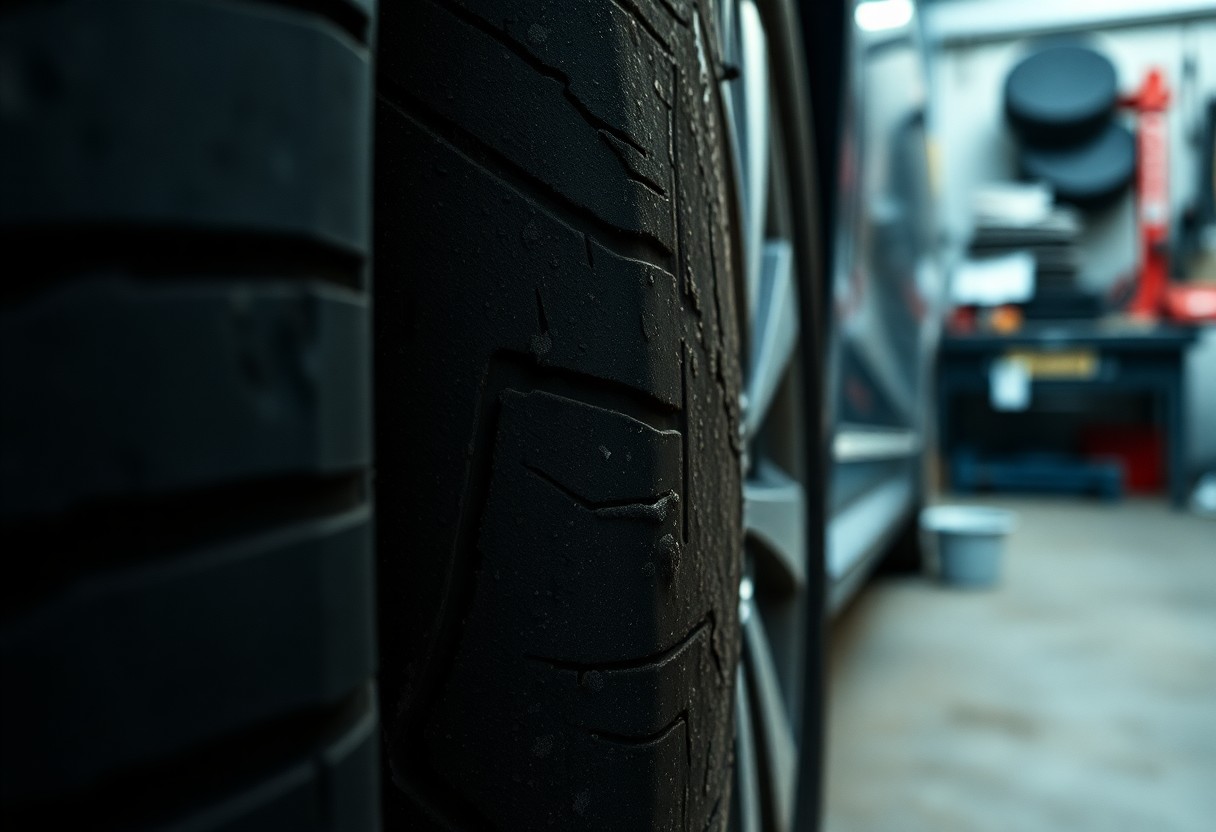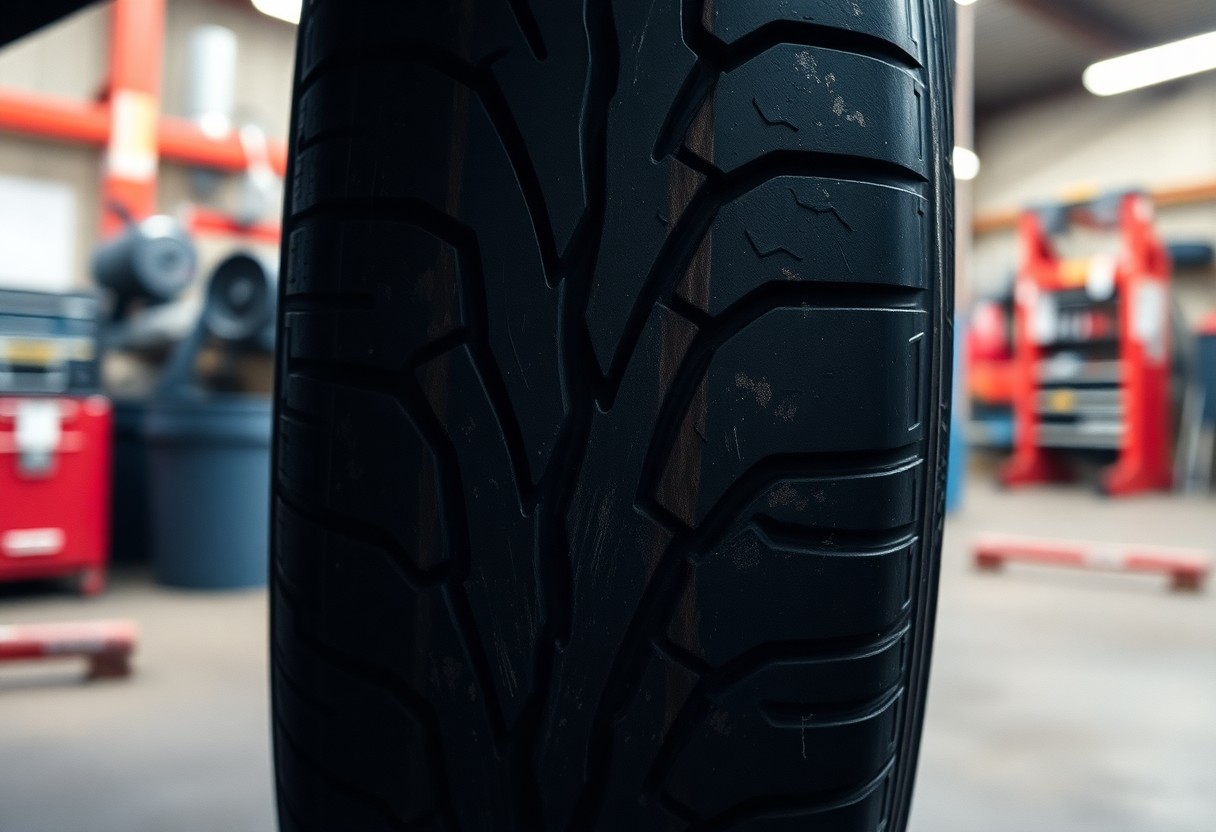Many vehicle owners overlook the importance of regularly checking their tyres, leading to dangerous situations on the road. By learning how to identify signs of wear, you can ensure your safety and extend the lifespan of your tyres. In this post, you’ll discover crucial tips to help you spot a worn-out tyre before it compromises your driving experience. For additional insights, check out this guide on How to Spot Early Signs of Tire Trouble Before It’s Too Late.

How to Identify Signs of Wear
A worn-out tyre can jeopardize your safety on the road. To ensure your vehicle performs optimally, you need to identify signs of wear early. Look for common indicators such as uneven tread wear, cracks, bulges, and bald spots. These signs not only affect your driving experience but can also lead to accidents if not addressed promptly.
Visual Inspection Techniques
Assuming you regularly check your tyres, start with a thorough visual inspection. Look for any visible damage, such as cuts or punctures, which may compromise tyre integrity. Additionally, inspect the surface for irregular wear patterns or discoloration, as these can signify underlying issues. A close examination can provide valuable insights into the condition of your tyres.
Checking Tread Depth
Depth of your tyre tread is important for maintaining traction and stability. To check tread depth, use a tread depth gauge or the penny test. Insert a penny into the groove with Lincoln’s head facing down; if you can see all of his head, it’s time to replace the tyre. Staying informed about your tread depth can help prevent loss of grip, especially in wet conditions.
Another effective method to check your tread depth is by utilizing the “wear bars” located in the grooves of the tyre. These thin rubber strips will become visible when the tread wears down to 1.6mm or less. If you notice that the wear bars are flush with the tread, your tyre is at the legal limit for tread depth, and it’s wise to consider a replacement for enhanced performance and safety.
Factors Affecting Tyre Longevity
Clearly, several elements can significantly impact the lifespan of your tyres, including:
- Tyre design and quality
- Maintenance practices
- Driving habits
- Road conditions
- Weather factors
Recognizing these factors can help you manage your tyre health better. If you want to learn more about how to tell when it is time to replace the tires on your vehicle, you can find valuable insights online.
Driving Habits
For many drivers, poor driving habits can lead to early tyre wear. Accelerating rapidly, hard braking, and taking sharp turns can all contribute to uneven wear and tear. You should strive for smooth acceleration and steady braking to prolong the life of your tyres.
Environmental Influences
While the environment plays a significant role in tyre longevity, factors such as temperature fluctuations, road surface, and exposure to UV rays can degrade your tyres over time. Tyres may harden or lose flexibility due to extreme heat or prolonged exposure to sunlight. Regularly inspecting your tyres in varying weather conditions can help you maintain their performance.
With changes in climate and road materials, you may find that your tyres experience different wear patterns. Wet or icy conditions can lead to hydroplaning or loss of traction, while rough roads can cause physical damage. Keeping an eye on weather forecasts and potential road hazards can help you make informed decisions about your driving and tyre maintenance routine.
Importance of Regular Maintenance
Now, maintaining your tyres is necessary to ensure optimal performance and safety. Regular maintenance can help you detect signs of wear and problems early on, preventing more significant issues and costly replacements. By taking care of your tyres, you also enhance your vehicle’s fuel efficiency and overall driving experience. Regular inspections and upkeep can go a long way in ensuring you drive safely on Klang’s roads.
Rotation and Alignment
Clearly, regular tyre rotation and alignment are key components of your vehicle’s maintenance routine. By rotating your tyres, you promote even wear across all four, extending their lifespan. Proper alignment ensures that your tyres wear evenly and maintain optimal contact with the road, enhancing handling and safety. Scheduling this maintenance can prevent premature wear and help you stay safe on the road.
Pressure Checks
With proper tyre pressure being critical for safety and fuel efficiency, routine pressure checks are a must. Under-inflated tyres can lead to decreased performance and excessive wear, while over-inflated tyres risk blowouts. You should check your tyre pressure at least once a month and before long trips, as temperature fluctuations can greatly affect it.
Importance of maintaining the correct tyre pressure cannot be overstated. Driving on improperly inflated tyres not only compromises your safety but also negatively impacts fuel efficiency. Too low or too high pressure can cause uneven wear, leading to a shorter lifespan for your tyres. Make it a habit to check your tyre pressure regularly, using a reliable gauge, to ensure optimal performance, better grip, and reduced stopping distance on the roads of Klang.

Tips for Extending Tyre Life
Not maintaining your tyres can lead to premature wear. To extend their lifespan, consider the following tips:
- Regularly check tyre pressure.
- Rotate your tyres every 5,000 to 8,000 km.
- Avoid sudden starts and stops.
- Keep an eye on alignment and balance.
- Limit high-speed driving on rough roads.
Any effort you make towards these practices will help you maximise the longevity of your tyres.
Proper Inflation
Extending the life of your tyres begins with proper inflation. When your tyres are under-inflated or over-inflated, they wear unevenly and can lead to reduced performance and increased fuel consumption. Check your tyre pressure at least once a month and adjust it according to the manufacturer’s recommendations found in your owner’s manual or on the driver’s side door jamb.
Choosing Quality Tyres
With the right quality tyres, you can significantly increase their durability and performance. Opt for reputable brands that meet safety standards, as cheaper options may save you money initially but can lead to faster wear and increased hazards on the road.
Another important aspect is to consider the tread pattern and rubber composition. Higher quality tyres often feature advanced technology that enhances traction, grip, and fuel efficiency. Investing in suitable tyres tailored for your driving conditions can greatly enhance both safety and longevity.

When to Replace Your Tyres
To ensure your safety on the road, it’s vital to know when to replace your tyres. Monitor their condition regularly, as worn-out tyres can greatly affect your vehicle’s performance and handling. As a rule of thumb, replace your tyres every six years, but factors such as tread wear, weather conditions, and driving habits can also influence the replacement schedule. Staying attentive to these aspects will help you maintain optimal safety while driving in Klang.
Recognizing Replacement Indicators
While you drive, keep an eye out for key indicators that signal it’s time for a tyre change. If you notice uneven tread wear, excessive vibrations, or bulges and cracks on the sidewall, these are signs that your tyres need attention. Additionally, if your tread depth is less than 1.6 mm (the minimum legal requirement), it’s time to head to the shop. By being proactive with these indicators, you can avoid potential accidents and improve your vehicle’s overall performance.
Timing Your Purchase
Clearly, the timing of your tyre purchase can significantly impact both your safety and wallet. Purchasing tyres when they are on sale can save you money, but it’s more important to prioritize the condition of your tyres over a bargain. If you’ve noticed any wear or performance issues, don’t delay in making the replacement. Buying new tyres during off-peak seasons can also lead to better deals, but always prioritize safety and tread performance over timing alone.
It’s vital to plan your tyre purchase strategically to ensure both your safety and financial well-being. Waiting until a sale can be tempting, but if you spot signs of wear or feel your vehicle handling poorly, replace your tyres immediately. An early investment protects you from potential accidents and saves you on costs related to mishaps caused by worn tyres. Consider balancing safety concerns with opportunities for savings, making sure you choose the right time for a replacement that also fits your budget.
Safety Considerations
Unlike various vehicle components, your tyres bear the brunt of everyday driving conditions. Wearing down over time, they can compromise your vehicle’s handling, grip, and braking ability. You must prioritize maintaining your tyres not just for performance, but for your safety and that of others on the road. Regular checks can mitigate risks associated with worn tyres, ensuring you and your passengers remain protected during your travels.
Impact of Worn Tyres on Performance
Performance is significantly affected by the condition of your tyres. Worn-out tyres can lead to reduced traction, longer stopping distances, and decreased fuel efficiency. When your tyres lose their tread, you may notice a decrease in cornering stability, making it harder to control your vehicle. For optimal performance, regular inspection and replacement of tyres are necessary to ensure a smooth and safe driving experience.
Legal Implications of Driving on Worn Tyres
Impact on your legal standing can be severe if you choose to drive on worn tyres. Many jurisdictions have specific regulations regarding tread depth and tyre maintenance. If caught with tyres in poor condition, you may face fines or penalties, and your vehicle may even be deemed unsafe for the road. This highlights the importance of staying informed about local laws to avoid unwanted legal issues while ensuring your safety.
Considerations regarding the legal implications of driving on worn tyres underscore the need for diligence. Not only can poor tyre conditions lead to fines, but they can also expose you to liability in the event of an accident. If your tyres contribute to a collision, you may find yourself accountable, facing insurance claims or lawsuits. Regularly monitoring your tyre condition not only promotes safety but also shields you from potential legal troubles.
Conclusion
Considering all points, regularly inspecting your tyres can save you from potential hazards on the road. By checking for uneven wear, cracks, and bulges, as well as monitoring tread depth, you can ensure your safety and maintain your vehicle’s performance. Don’t wait until it’s too late; being proactive about tyre maintenance not only enhances your driving experience but also extends the life of your tyres. Stay informed and vigilant, and you’ll be better equipped to deal with any issues that arise.
